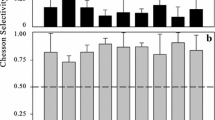Abstract
Fluorescent beads were used to determine the grazing on bacteria by heterotrophic and mixotrophic flagellates in a highly humic (water colour 300–600 mg Pt l−1) small lake. In summer phagotrophic flagellates constituted about three quarters of the numbers of phytoplankton (including heterotrophic or mixotrophic flagellates) in the uppermost epilimnion. Due to their small size their respective contribution to the biomass was about one quarter. The most important phagotrophic species were Ochromonas sp., and Chromulina spp. which ingested 75–203% of their body carbon per day from bacteria.
In view of the abundance and biomass of phagotrophic and mixotrophic flagellates and their very high growth potential, they clearly play a significant role in the food chains of this lake. In addition to providing energy, bacteriovory also represents an important supply of inorganic and organic nutrients under nutrient limiting conditions.
Similar content being viewed by others
References
Aaronson, S., 1974. The biology and ultrastructure of phagotrophy in Ochromonas danica (Chrysophyceae: Chrysomonadida). J. Gen. Microbiol. 83: 21–29.
Aaronson, S. & H. Baker, 1959. Comparative biochemical study of two species of Ochromonas. J. Protozool. 6: 282–284.
Andersen, P. & T. Fenchel, 1985. Bacteriovory by microheterotrophic flagellates in seawater samples. Limnol. Oceanogr. 30: 198–202.
Azam, F., T. Fenchel, J. G. Field, J. S. Gray, L. A. Meyer-Reil & E. Thingstad, 1983. The ecological role of water-column microbes in the sea. Mar. Ecol. Progr. Ser. 10: 257–263.
Bergström, I., A. Heinänen & K. Salonen, 1986. Comparison of acridine orange, acriflavine, and bisbenzimide stains for enumeration of bacteria in clear and humic waters. Appl. envir. Microbiol. 51: 664–667.
Bird, D. F. & J. Kalff, 1987. Algal phagotrophy: Regulating factors and importance valative to photosynthesis in Donobryon (Chrysophyceae). Limnol. Oceanogr. 32: 277–284.
Bjørnsen, P. K., 1986. Automatic determination of bacterioplankton biomass by image analysis. Appl. envir. Microbiol. 51: 1199–1204.
Bratbak, G., 1985. Bacterial volume and biomass estimations. Appl. envir. Microbiol. 49: 1488–1493.
Børsheim, K. Y. & G. Bratbak, 1987. Cell volume to cell carbon conversion factors for bacteriovorous Monas sp. enriched from seawater. Mar. Ecol. Prog. Ser. 36: 171–175.
Cynar, F. J. & J. McN. Sieburth, 1986. Unambiguous detection and improved quantification of phagotrophy in apochlorotic nanoflagellates using fluorescent microspheres and concomitant phase contrast and epifluorescence microscopy. Mar. Ecol. Progr. Ser. 32: 61–70.
Droop, M. R., 1953. Phagotrophy in Oxyrrhis marina Dujardin. Nature 172: 250–251.
Dubowsky, N., 1974. Selectivity of ingestion and digestion in the chrysomonad flagellate Ochromonas malhamensis. J. Protozool. 21: 295–298.
Estep, K. W., P. G. Davis, M. D. Keller & J. McN. Sieburth, 1986. How important are oceanic algal nanoflagellates in bacteriovory? Limnol. Oceanogr. 31: 646–650.
Fenchel, T., 1982a. Ecology of heterotrophic microflagellates. I. Some important forms and their functional morphology. Mar. Ecol. Progr. Ser. 8: 211–223.
Fenchel, T., 1982b. Ecology of heterotrophic microflagellates. II. Bioenergetics and growth. Mar. Ecol. Progr. Ser. 8: 225–231.
Fenchel, T., 1982c. Ecology of heterotrophic microflagellates. III. Adaptations to heterogeneous environments. Mar. Ecol. Progr. Ser. 9: 25–33.
Fenchel, T., 1982d. Ecology of heterotrophic microflagellates. IV. Quantitative occurrence and importance as bacterial consumers. Mar. Ecol. Progr. Ser. 9: 35–42.
Fenchel, T., 1986. The ecology of heterotrophic microflagellates. Adv. Microbial Ecol. 9: 57–97.
Fenchel, T. & B. J. Finlay,1983. Respiration rates in heterotrophic, free-living protozoa. Microb. Ecol. 9: 99–122.
Goldman, J. C. & D. A. Caron, 1985. Experimental studies on an omnivorous microflagellate: implications for grazing and nutrient regeneration in the marine microbial food chain. Deep Sea Res. 32: 899–915.
Heldal, M., S. Norland & O. Tumyr, 1985. X-ray microanalytic method for measurement of dry matter and elemental content of individual bacteria. Appl. envir. Microbiol. 50: 1251–1257.
Ishida, Y. & B. Kimura, 1986. Photosynthetic phagotrophy of Chrysophyceae: evolutionary aspects. Microbiological Sciences 3: 132–135.
Kimura, B. & Y. Ishida, 1985. Photophagotrophy in Uroglena americana. Chrysophyceae. Jap. J. Limnol. 46: 315–318.
McManus, G. B. & J. A. Fuhrman, 1986. Bacteriovory in seawater studied with the use of inert fluorescent particles. Limnol. Oceanogr. 31: 420–426.
Mueller, M., P. Röhlich & I. Toro, 1965. Studies on feeding and digestion in Protozoa. VII. Ingestion of polystyrene latex particles and its early effect on acid phosphatase in Paramecium multimicronucleatum and Tetrahymena pyriformis. J. Protozool. 12: 27–34.
Norland, S., M. Heldal & O. Tumyr, 1987. On the relation between dry matter and volume of bacteria. Microb. Ecol. 13: 95–101.
Porter, K. G., E. B. Sherr, B. F. Sherr, M. Pace & R. W. Sanders, 1985. Protozoa in planktonic food webs. J. Protozool. 32: 409–415.
Ryhänen, R., 1968. Die Bedeutung der Humussubstanzen im Stoffhaushalt der Gewässer Finnlands. Mitt. int. Ver. Limnol. 14: 168–178.
Salonen, K. & T. Hammar, 1986. On the importance of dissolved organic matter in the nutrition of zooplankton in some lake waters. Oecologia (Berl.) 68: 246–253.
Schell, D. M., 1983. Carbon-13 and carbon-14 abundances in Alaskan aquatic organisms: Delayed production from peat in arctic food webs. Science 219: 1068–1071.
Sherr, E. B. & B. F. Sherr, 1987. High rates of consumption of bacteria by pelagic ciliates. Nature 325: 710–711.
Straskrabova, V. & J. Komarkova, 1979. Seasonal changes of bacterioplankton in a reservoir related to algae. I. Numbers and biomass. Int. Rev. ges. Hydrobiol. 64: 285–302.
Wetzel, R. G., 1983. Limnology. Saunders College Publishing, Philadelphia. 753 pp.
Author information
Authors and Affiliations
Rights and permissions
About this article
Cite this article
Salonen, K., Jokinen, S. Flagellate grazing on bacteria in a small dystrophic lake. Hydrobiologia 161, 203–209 (1988). https://doi.org/10.1007/BF00044111
Issue Date:
DOI: https://doi.org/10.1007/BF00044111




